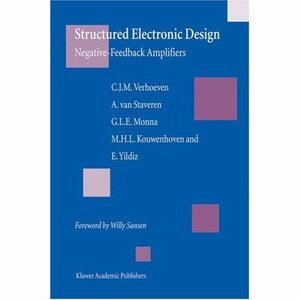Structured Electronic Design Negative-Feedback Amplifiers
2010年07月08日 16:44 发布者:techieboy
Analog design is one of the more difficult aspects of electrical engineering. The main reason is the apparently vague decisions an experienced designer makes in optimizing his circuit. To enable fresh designers, like students electrical engineering, to become acquainted with analog circuit design, structuring the analog design process is of utmost importance.Structured Electronic Design: Negative-Feedback Amplifiers presents a design methodology for negative-feedback amplifiers. The design methodology enables to synthesize a topology and to, at the same time, optimize the performance of that topology.
Key issues in the design methodology are orthogonalization, hierarchy and simple models. Orthogonalization enables the separate optimization of the three fundamental quality aspects: noise, distortion and bandwidth. Hierarchy ensures that the right decisions are made at the correct level of abstraction. The use of simple models, results in simple calculations yielding maximum-performance indicators that can be used to reject wrong circuits relatively fast.
The presented design methodology divides the design of negative-feedback amplifiers in six independent steps. In the first two steps, the feedback network is designed. During those design steps, the active part is assumed to be a nullor, i.e. the performance with respect to noise, distortion and bandwidth is still ideal.
In the subsequent four steps, an implementation for the active part is synthesized. During those four steps the topology of the active part is synthesized such that optimum performance is obtained. Firstly, the input stage is designed with respect to noise performance. Secondly, the output stage is designed with respect to clipping distortion. Thirdly, the bandwidth performance is designed, which may require the addition of an additional amplifying stage. Finally, the biasing circuitry for biasing the amplifying stages is designed.
By dividing the design in independent design steps, the total global optimization is reduced to several local optimizations. By the specific sequence of the design steps, it is assured that the local optimizations yield a circuit that is close to the global optimum. On top of that, because of the separate dedicated optimizations, the resource use, like power, is tracked clearly.
Structured Electronic Design: Negative-Feedback Amplifiers presents in two chapters the background and an overview of the design methodology. Whereafter, in six chapters the separate design steps are treated with great detail. Each chapter comprises several exercises. An additional chapter is dedicated to how to design current sources and voltage source, which are required for the biasing. The final chapter in the book is dedicated to a thoroughly described design example, showing clearly the benefits of the design methodology.
In short, this book is valuable for M.Sc.-curriculum Electrical Engineering students, and of course, for researchers and designers who want to structure their knowledge about analog design further.
Written for:
M.Sc.-curriculum electrical engineering students, researchers, designers

18413
18414
18415
网友评论
bjsummercn 2010年07月24日
FFFFFFFFFFFFFFFFFFFFFFF
FFFFFFFFFFFFFFFFFFFFFFF
bjsummercn 2010年07月24日
DDDDDDDDDDD
DDDDDDDDDDD
ericyz1998 2010年11月21日
谢谢分享
谢谢分享
xwcwc1234 2010年12月22日
學習學習~~
學習學習~~
sisc1525 2011年01月19日
不错的book
不错的book
tony02778 2012年03月12日
多謝
多謝
tony02778 2012年03月12日
果然好物
果然好物
秒宿 2016年05月25日
多謝
多謝
FlyiNgDutch 2016年06月27日
学习 学习
学习 学习
shancjb 2018年06月12日
xialia kankan
xialia kankan

DFDFDFDFHHHHHHHHHHHHHHHHHHHHHHHHHHHHHHHHHHH